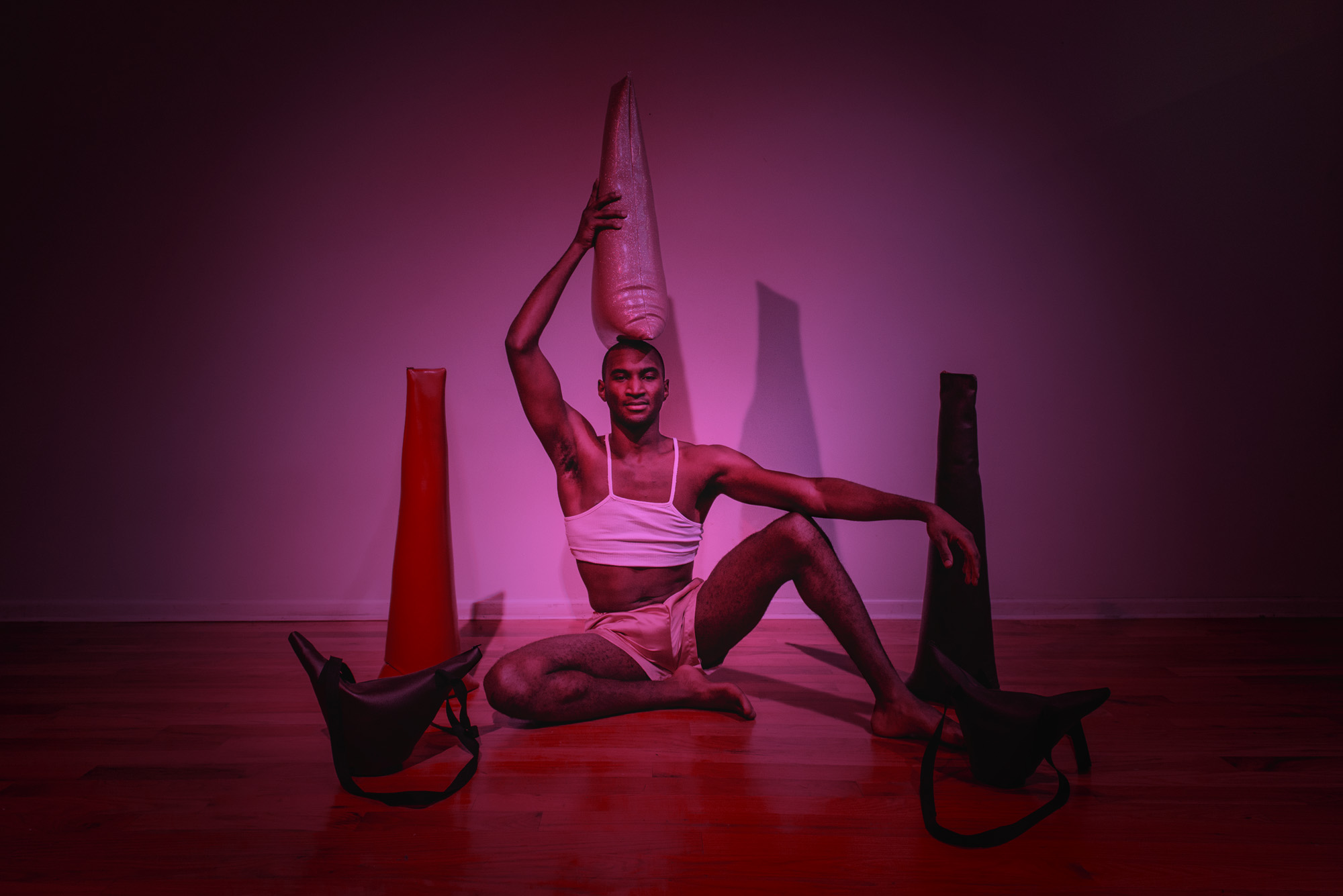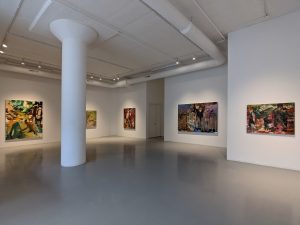“Intimate Justice” looks at the intersection of art and sex and how these actions intertwine to serve as a form of resistance, activism, and dialogue in the Chicago community. For this installment, we talked to Cameron Clayborn in his Bridgeport live-work studio space about popcorn ceilings, inner dialogue, and letting your freak flag fly.
This interview has been edited for length and clarity.
S. Nicole Lane: Are you from Chicago? If not, how did you end up here?
Cameron Clayborn: I’m from Memphis. I was born in Pine Bluff, Arkansas, and then my parents moved me to Memphis.
SNL: Cool. And do you live in Bridgeport?
CC: Yeah. So this is a live-work space. Everyone who has a space here works here, except for one person. But she’s awesome. So she lives around the corner.
SNL: And what did you study at SAIC?
CC: I studied sculpture and sometimes sound. I never took a performance class except for one time, which was about the practicalities of being a performance artist. I don’t know, it just never felt like it was the best thing for me to do. I don’t know. Taking a performance class there just always felt a little weird. But now, thinking back on it, I could have taken them, but really all I ever did was just hang out with the performance kids and mainly the MFA performance people, so that was my way of being in the scene or whatever. Because otherwise I was not interested. Did you go there?
SNL: No, I didn’t. I went to school in North Carolina. And then I moved here with a partner of mine which I’m not with anymore. I had never been to Chicago, and I love it.
CC: It’s the best city. I do love Chicago. It’s crazy but it’s cool. [laughs]
SNL: It’s crazy, yeah. So you make work in a lot of different mediums. How is that process different for each medium that you’re working with? Or how do you work through those different processes?

CC: Oh, it’s always a crazy-ass balance. Even right now, it’s even more insane, just because it’s about circulation, like where our work gets to go and how it’s being able to be processed. So sometimes we’re always just like, “Mmm, are we able to actually fit inside this space because we don’t want to use this language?” or something like that. So, for me, it really is about circulation, the reason why I make so many different kinds of things [is] because I want someone to be able to travel with my work and not just be able to see it in a static space. But then, usually or most of the time, it’s all sourced from the same content, where it’s like, my body, or something autobiographical. It could be as simple as a color. It’s always coming from the same sort of source, and then it just explodes out into these different things. So, right now, I’m super obsessed with my grandma’s ceiling.
Do you remember the popcorn ceiling? My grandma, she actually had glitter in hers. It was in this one room in the back of her house, and I used to sleep in that room after I moved out of her bed and was like grown enough to sleep in my own when I would go to visit her. And it’s like, I don’t know, ever since then I’ve been like super obsessed with it. Because after my grandfather passed away, she was pretty much the matriarch of the family and sort of had that home and that was like her thing. I see it is her work, since they built it on their own. I don’t know, for some reason any time I think about that glitter ceiling, it’s nostalgic but it’s also feminine. I can wander in it for some reason. Because the glitter wasn’t always easy to find. So you kind of had to move your body in order to see it.
But yeah, I presented it inside of this big-ass box and it was like, mobile and being pushed around with an amplifier.
SNL: So the popcorn piece that was mobile—what exactly is it?
CC: It was this gigantic box—maybe not that big, but big enough for my body to fit inside. And then I had this amplifier installed on top of it, and then one of my friends sort of pushed me around and I could talk to people. And so, the thing about the amplifier is, we set it to an echo, so when I’m talking to people it sounds like it’s an echo chamber but then also it sounds like I’m lost in space or something inside of there. And the piece is called “A Mobile Portion of Granny’s Home.” Everyone always thinks that I know secrets. They’re like, “Oh, don’t you have any secrets to tell?” [Nicole laughs] “Where are you? What’s your purpose in this?” I don’t know, it was really strange questions. They’re always just trying to figure out what the box is. [both laugh]
SNL: Did you explain to them what it was?
CC: No, just because in that sense that’s where I get to kind of flirt with the guests? And I feel like, to me, the essence of flirting is always sort of being aware of knowing that you have a particular content in your mind that you don’t want to forgive yet, or give over yet. So it’s like, always sort of fun to be like, “Oh, yeah, I am a box, but I’m only going to be here for a couple minutes.” You know? And you throw it completely off and they’re just like, “Oh, okay.” So it’s all that enticing conversation is really what it’s about. To me, it’s the art of conversation more than anything. And then also my social anxiety. [both laugh] You know? Because I’m like, “I’d rather be inside this box instead of actually have to interact with you.”
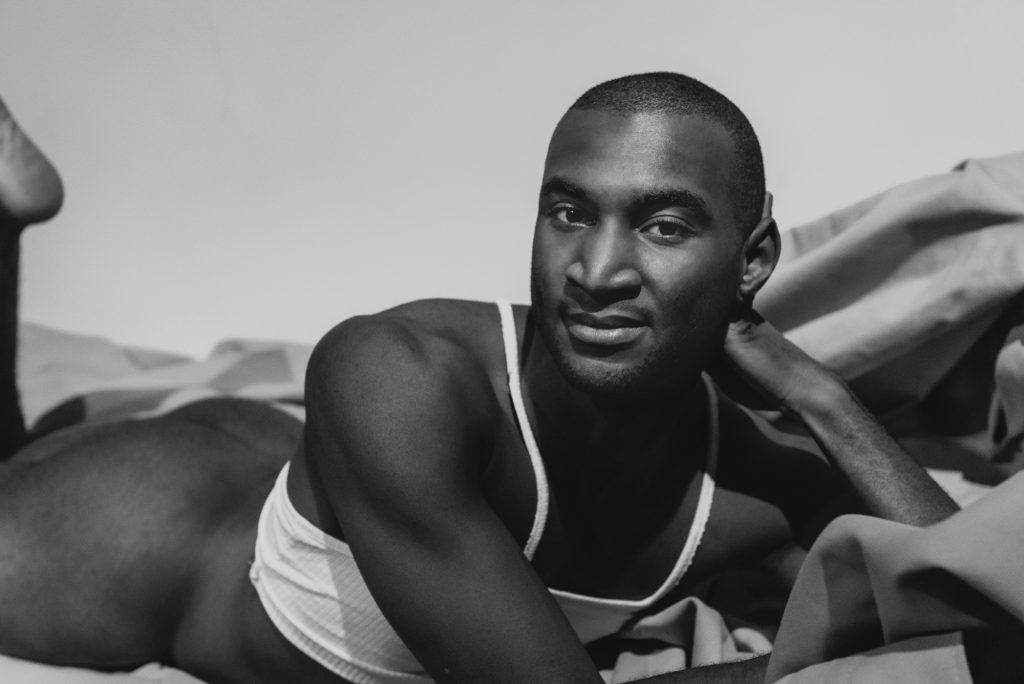
SNL: Because they also become more comfortable, too, talking to you.
CC: Yeah, talking to me. Because there’s no inhibitions.
SNL: Yeah. So in your other performative work, how do you get past that social anxiety?
CC: That’s why I’m actually about to start pursuing acting, too. Not as a career or anything. I just kind of want to try it. Because I’ve never respected it as an artistic medium, really, until recently.
I just sort of forfeit my body for the sake of the idea. So then I just have no choice but to do whatever it is I have to do. Which is kind of interesting, because the first kind of set of performances that I did coming out of school was set to this track that I made with my own voice, that was then dubbed super duper low, and it told me what to do in the space, while also telling particular stories about me. So it was sort of omniscient, sort of like a narrator. And so I feel like that, to me, is that same sort of forfeiting. Having my inner dialogue—which is pretty much all that voice was—telling me what to do. It helped me shift in because I was already using whatever anxiety I had to channel it.
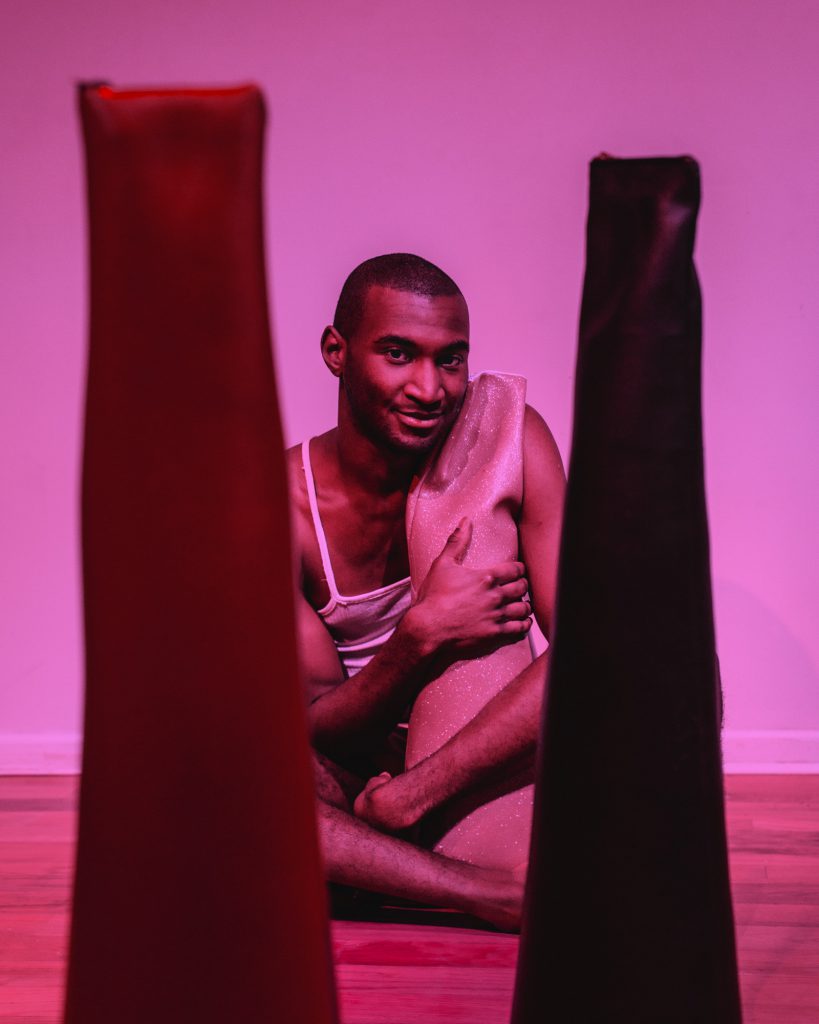
SNL: Could you talk a little bit about how or why you’re drawn to using your body or bodies in some of your work?
CC: Yeah. That’s a big, big question. [laughs] I grew up with a dad who was very physically active, and a coach. He put me into a lot of sports and things like that. So physicality and using my body is something that I just know very well. I think when I did kind of come to art school, I started understanding that that physicalness that I was desiring for could be served in performance art. Yeah, so that’s probably the reason I use my body, because it makes sense to do.
SNL: When you’re working through performance work, do you sketch things out? Or how does that work? How does the beforehand planning go?
CC: Yeah, it’s happening right now. I wanted to do a performance in this space called “Loud, Organic, Lovely.” It’s been, to me, a built-up performance of maybe about two years. Usually, I’m so object-based. I have to make the set first, and then I start working with it. So the performances I did as I came out of school, with these big sack pieces, I actually asked my friend who was a choreographer to help me understand the objects more. Because watching her interact with them and being like, “Oh, this is kind of how I can shift around this and turn that over to here….” Usually sometimes if I don’t have the language myself, I just ask someone who does! [laughs]
SNL: And in terms of the sculptural work: The sacks, are those–?
CC: Well, they’re called container bags. That’s the language I use. The container bags are just literally sourced from my body measurements. So the way I kind of came about those was through my research into fetishism. Which was interesting, because the more I started researching it, the more I started to understand that the word “fetish” itself is kind of an inherently racist terminology. And the objects that that word is in reference to are like called “nkisi nkondis” and they’re from West Africa. And they’re like religious sculptures that these people would make and then they would actually nail into the sculpture itself in order to activate its power. I mean that’s just kind of the progression of western or colonialist thought. After sort of researching that, I was like, “I feel this kind of intimacy towards my objects.” And for me I just liked that weird language of just using my body in order to work my body out.
I just sourced it from a body measurement or even from someone else’s body that I want to conjure in the space. For the last one, it was my dad. I took his body measurements and then I sort of made them up. Yeah, and then I filled them with sand, and then usually I work out with them.
SNL: Do you view your work as resistance? Do you have any thoughts on that? Or has your work changed in any way, in the last two years, since the election? Or has it not?
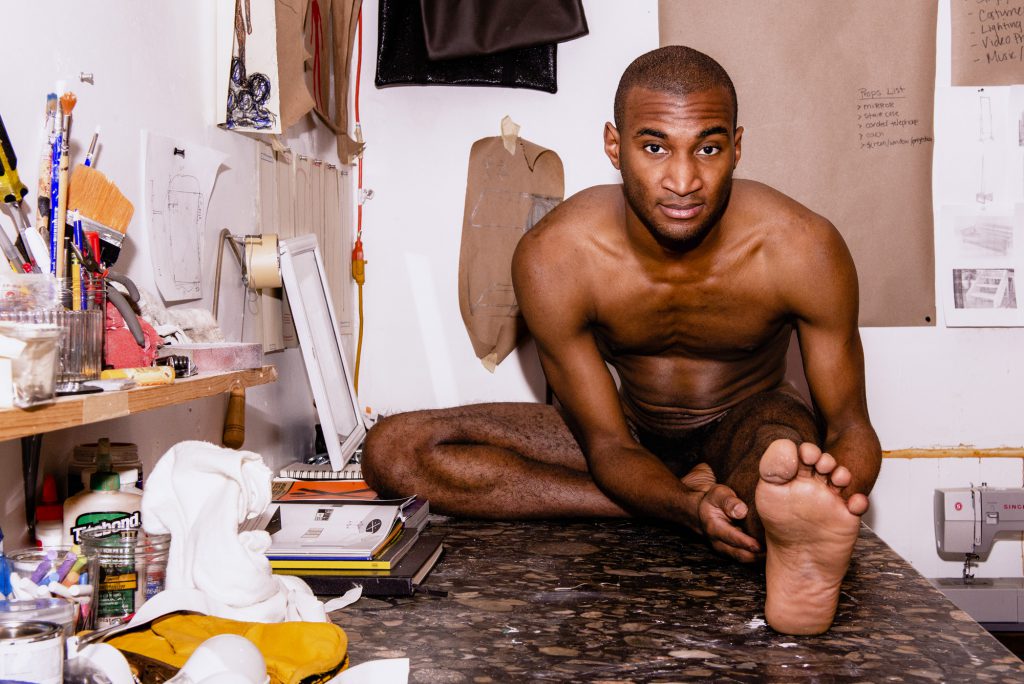
CC: Yeah yeah yeah. I think that visibility is something that really matters a lot to me. I feel like it’s so important that my image be present wherever it can be present. I mean, as far as the art community, I used to be upset at the exclusivity of it, but now I’m starting to understand that, really, it’s not as exclusive as we think it is. People can come and go if they want. It’s just that usually I think that the content and things that we want to do are usually what people don’t want to talk about, and they don’t want to celebrate it, and they don’t want to be in the space of it. It’s also that some of the work is kind of political, is hella Black, is hella gay, is hella queer, and people don’t know how to react to that. And they would just rather not be in that space. And that’s what I love about art people so much! It doesn’t mean that we’re right, it doesn’t mean that they’re any more aware or not socially conscious. I mean, trust me, I’ve been around plenty of art people who say stupid-ass shit all the time. But they’re still present in the space and they’re present to have dialogue, and I think that, any time we have an art show, to me that’s a celebration of expression. Which I think we shouldn’t forget about that. And I think sometimes we do, just because, you know, ego gets in the way and we all want to be art stars.
If I want to make an artwork that is me twerking, to some weird inner-dialogue voice, I can fucking do that, and you should be able to watch it, and you should all watch it. I just feel like we should all let our freak flags fly as we want. [laughs] You know? Fuck it. Like, that’s the only way you can resist. That to me is resistance. It’s just being. You know, so many of us are not being, just because they’re afraid to be.
Featured Image: The image is in color and has a pink hue. The artist is seated with a “container bag” on her head. She is holding it with one arm. The other leg is propped up. Two other “container bags” are framing the artist’s body and two smaller ones are on the floor. She is wearing a white tank top and shorts. Photo by Ryan Edmund Thiel.
 S. Nicole Lane is a visual artist and writer based in the South Side. Her work can be found on Playboy, Broadly, Rewire, i-D and other corners of the internet, where she discusses sexual health, wellness, and the arts. She is also the Office Manager for the Chicago Reader. Follow her on Twitter.
S. Nicole Lane is a visual artist and writer based in the South Side. Her work can be found on Playboy, Broadly, Rewire, i-D and other corners of the internet, where she discusses sexual health, wellness, and the arts. She is also the Office Manager for the Chicago Reader. Follow her on Twitter.
Photo by Jordan Levitt.
